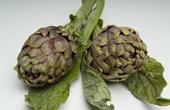Artichoke

General information
Perennial plant of the family of astroids, in the wild it occurs in the countries of Southern Europe. Its cultural forms were brought to Russia under Peter I and cultivated as ornamental and medicinal plants. In appearance, the artichoke is similar to a thistle plant, but it has larger inflorescences of blue color. The stem is branchy, up to 1.5 m high, growing from the rosette of large pinnate gray-green leaves. Inflorescences( baskets) globose, conical or flat, with a diameter of up to 12-20 cm, covered with thickened scales at the base. Inside the baskets, a lot of small flowers are planted, sitting on a fleshy flower-root.
Requirements
Artichoke is a heat-demanding culture. Frost tolerates poorly. When cultivated in a perennial culture, it is required to cover plants for the winter.
Composition of
Differs high in carbohydrates, inulin, proteins, mineral salts, vitamins C, B1, B2, carotene and aromatics.
Cultivation of
In order to receive production in the first year, in the central part of Russia the artichoke is grown by seedlings. To this end, large seeds are taken at the end of February, germinate them before pecking at a temperature of 20-25 ° C, and then are kept in the refrigerator at 0-1 ° C for 10-15 days. Sow seeds in rows in boxes or pots with soil mixture from humus, turf and sand, taken in equal parts, and put on a well-lit place in the sun. Shoots are regularly watered with warm water and fed with weak solutions of mineral and organic fertilizers. In late April - early May, the seedlings are tempered and in the second half of May planted in open ground on well-filled soil. In the holes before planting, 400-500 grams of humus, mixed with wood ash, are applied. The roots of plants when planting spread, fall asleep with soil, compact it and water. The planting pattern is 70 x 70 cm.
Sorts
The best artichoke grades are Violet large, Large green, Laon and Maikop.
Care
Regular abundant watering, loosening, fertilizing and weeding. With the advent of inflorescences, plants are watered less often and less water. In order for the inflorescences to be larger, 1-2 flower stems with 2 baskets are left on the plant, the remaining shoots are removed.
Harvesting
Inflorescences are considered ready for harvest when the scales in the upper part begin to unfold. To the mass collection of baskets begin in August and continue it until the onset of stable frosts. In this case, the inflorescence is cut together with a stem up to 15 cm in length. Store the artichoke at a temperature of 0-1 ° C for about a month.
Usage of
Fleshy receptacle is used for food and juicy bases of scales for fruitfulness. In their raw form, they taste like unripe walnuts, they prepare salads with tomatoes and herbs, seasoning with sour cream, mayonnaise, vegetable oil. Artichoke fry, boil and marinate. Plants it is recommended also in medical nutrition to people suffering from kidney, gallbladder, diabetes and atherosclerosis.
